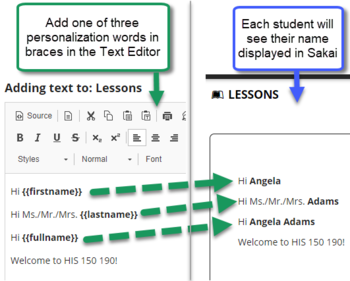Difference between revisions of "Sakai: Lessons"
| Line 82: | Line 82: | ||
*** A peer review rubric is available for each page or you can add your own peer review rubric | *** A peer review rubric is available for each page or you can add your own peer review rubric | ||
*** Students can self-grade or grade peers or groups | *** Students can self-grade or grade peers or groups | ||
| − | * Here's a handout you can share with your students '''[[Media: For_Students-_How_to_Work_with_Student_Pages_Handout.pdf|For Students: How to work with Student Pages (PDF)]]''' with step-by-step instructions | + | * Here's a handout you can share with your students '''[[Media: For_Students-_How_to_Work_with_Student_Pages_Handout.pdf|For Students: How to work with Student Pages (PDF)]]''' with step-by-step instructions. |
| − | |||
| − | |||
| − | |||
| − | |||
Revision as of 11:23, 20 August 2020
Contents
Lessons
Lessons is a flexible tool for adding content to your Sakai site.
- With the Lessons tool, you can share all kinds of content with students, including web links, documents, videos, and links to assignments, tests/quizzes, and forums.
- You can also create weekly subpages to organize your content, so students can find the week's materials and assignments all together in one place.
If you're teaching an online or hybrid course, it's important to use the Lessons tool to organize the content for each week of the course. (The Lessons tool can be useful for face-to-face courses as well.)
Getting Started
What content should you add to Lessons? how can you organize it?
- Based on information gathered from experienced instructors, here's a template you can use to organize your content for your lessons:
Basics
Intermediate
- How to Build a Well-Designed Subpage: Video | Handout
- Embedding (Displaying) YouTube videos in Sakai: Video | Handout
- Linking and Embedding Films on Demand videos in Sakai: Handout
- Organizing Your Lessons Subpages and Course Menu: Video | Handout
- How to link to an assignment, test/quiz, forum topic, and link to a website from a Lessons page
- How to enable Lessons subpage navigation in the Tool Menu
Best Practices for Using Sakai's Lessons and Course Design
Add section breaks and color to sections
Add color to Lessons content areas, add horizontal section breaks, add content above and below your present content
Working with Sections and Columns
- How do I create multiple sections on a Lessons page?
- How do I create two columns on a Lessons page?
- How do I merge columns and sections to one block?
- How do I create a collapsible section?
Interactive Features
Personalize Text to Display a Student's Name
In the Sakai Text Editor you can add double sets of braces (not parens or brackets) around one of three specific words, to display either the student's first name (firstname), last name (lastname), or full name (fullname), based on how their name appears on the Sakai Roster:
Checklist
With the new Checklist feature, instructors can add a "to-do" list to any Lessons page, which helps students stay on track and allows instructors to view their progress.
- How to create a checklist in Lessons Instructions
Question
Instructors can add a Multiple Choice or Short Answer question directly to a Lessons Page. The questions can be graded (correct answer specified) or used for polling (no correct answer specified).
Comments
Instructors can allow students to add comments to a Lessons page. The comments can be graded.
Student Content (aka Student Pages)
The Student Content feature in Lessons is great for student projects.
- If you enable this feature, students (or groups) will be able to create their own pages in Lessons, containing text, web links, pictures, videos, and links to documents.
- Follow these steps to add the Student Content feature to your Lessons area: How to allow students to add content to Lessons
- Here's some of the capabilities of Student Pages:
- Students can work on their individual student page, or groups can work together on a student page
- Comments can be added to each student page
- You can grade student pages and/or comments
- Peer review rubrics are available; but you must inform students of peer review deadlines
- A peer review rubric is available for each page or you can add your own peer review rubric
- Students can self-grade or grade peers or groups
- Here's a handout you can share with your students For Students: How to work with Student Pages (PDF) with step-by-step instructions.
